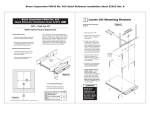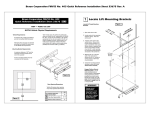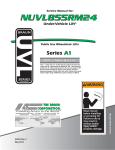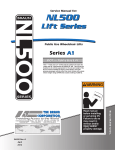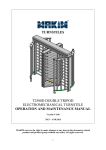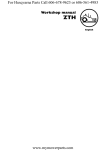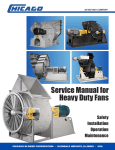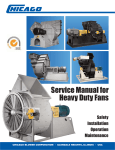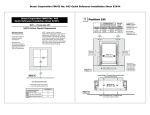Download Braun Personal Lift 403 User's Manual
Transcript
Braun Corporation FMVSS No. 403 Quick Reference Installation Sheet 34274 Rev. A Braun Corporation FMVSS No. 403 Quick Reference Installation Sheet 34274 1 Locate Lift Mounting Brackets Rev: A Locate Lift Mounting Brackets Alternative floor structures are allowed providing the installed lift system passes all FMVSS 403 requirements. ACR OSS FRA ME O P E N IN G E 90 " 3/8 22" 3/8 22- 4. Measure 22-3/8" to left and right of the center line to achieve the 44-3/4" center-tocenter spacing of all-thread mounting studs. " 3/4 44- 5. Clamp the mounting brackets securely in place (all-thread studs must be vertical). Lift Mounting Brackets (typical both sides) Figure A Mounting Bracket Requirements: All four mounting brackets must be connected to the vehicle chassis floor members. B A NUVL855RM24 C Engage Platform Manual Release System: The lift cable-activated platform manual release is disengaged during shipment to prevent potential drive chain stretch. Handle the lift with care. Engage manual release before attempting to install (raise, tilt or move) the lift. Door Opening Dimensions: Vehicle lift access door opening must meet specified dimensions. Figure B TER ICL O Vehicle Floor Chassis Members 3. Transfer center point to the vehicle frame. Using a frontto-rear framing member as a guide, transfer the center point across chassis to opposite side front-to-rear framing member (must be 90° to door opening). Lift mounting bracket positions are based on this center line. IN ER G NT NIN CE OPE OR DO CL CEN VEH O Vehicle Requirements: 2. Locate center of door opening. Mark the center point. D NHTSA Vehicle Physical Requirements “DOT - Public Use Lift” verifies this platform lift meets the “public use lift” requirements of FMVSS No. 403. This lift may be installed on all vehicles appropriate for the size and weight of the lift, but must be installed on buses, school buses, and multi-purpose passenger vehicles other than motor homes with a gross vehicle weight rating (GVWR) that exceeds 4,536 kg (10,000 lb). All vehicles with a GVW over 6000 lbs. and with unmodified OEM framerails. Figure C 1. Open door(s) fully (min. 90°). R “DOT — Public Use Lift” A Minimum Clear Door Opening Height B Clear Door Opening Width 43½" C Maximum Floor-to-Ground 62½" NA WARNING Engage manual release before attempting to install (raise, tilt or move) lift. Failure to do so may result in serious bodily injury and/or property damage. All-Thread Mounting Studs Inboard Left Right Outboard Braun Corporation FMVSS No. 403 Quick Reference Installation Sheet 34274 Rev. A 2 5/16-18 x 1" Hex Bolt Secure Lift 1. Attach Mounting Brackets to Vehicle Framing Members Position lift mounting brackets as detailed in Step 1 (see Figures C, D and F). Oval slotted mounting holes are provided in the mounting brackets to allow adjustment. Carefully drill 21/64" (.328") diameter mounting holes at the center of the oval mounting slots (holes may be present). Flat Washer (typical) Figure D All-Thread Stud Vehicle Framing Members Twenty 5-16-18 x 1" hex bolts are supplied for bolting the lift mounting brackets to the vehicle framing member (four per inboard bracket and six per outboard bracket). 2. Position and secure lift. Thread two 3/4" hex jam nuts fully onto each mounting bracket all-thread stud. Place one large diameter flat washer onto each all-thread stud. See Figures G and H. Carefully position lift in vehicle (aligned with mounting brackets). Position (slide) the six lift mounting clamps along the sides of the lift housing until aligned with mounting bracket all-thread studs. See Figure F. Lower lift onto mounting bracket studs Jam Nuts Inboard Mounting Bracket Lift Clamp Flat Washer Place a flat washer onto each mounting bolt. Insert bolts through mounting bracket, vehicle floor and framing member as shown in Figure D. Installation is typical for all brackets (outboard brackets require 6 mounting bolts each). Jam Nuts Lock Washer (typical) All-Thread Stud Nylock Hex Nut (typical) Figure F All fasteners must meet FMVSS 571.403 Section 6.3. Figure E 3. Height Adjustment 4. Horizontial Adjustment C The lift outer barrier must be aligned with the vehicle access hole. The lift housing must be aligned with vehicle chassis (level). Adjust the 3/4" hex jam nuts on the allthread mounting studs at all 4 corners of the lift until dimensions A, B, C and D are equal (within 1/16"). See Figure G. Jam Nuts Position the lift to achieve a 2” overlap between the deployed inboard barrier and the vehicle floor. Shift lift and mounting brackets left-to-right as needed (lift must be centered in door opening). Tighten the 5/16" bolts securing mounting brackets (shown in Figure D) to the frame. Flat Washer Lift Clamp B Torque Specifications: 20 foot pounds. Flat Washer Tighten upper set of 3/4" hex jam nuts (with flat washer) down to the lift mounting clamps. Tighten jam nuts. Jam Nuts All-Thread Mounting Stud Place one large diameter flat washer onto each mounting bracket allthread stud. Thread two 3/4" hex jam nuts fully onto each all-thread stud (against lift mounting clamp). In-Out Positioning Lift Housing 2-1 /2" Dimensions A, B, C and D must be equal (within 1/16"). Figure G Torque Speci cations: 100 to 120 foot pounds. 10¼” Shipping Block Removal: D 5-3 Mounting Bracket /8" A Figure H Wood blocks are placed in the lift housing to prevent lift damage during shipment. Remove shipping blocks from platform and carriage before running (activating) lift. Refer to Shipping Block Removal Instruction 28942. Braun Corporation FMVSS No. 403 Quick Reference Installation Sheet 34274 Rev. A 3 Electrical, Hydraulic and Interlock 1/4-20 x 3/4" Hex Bolts (Typical) Note: Locate and drill hydraulic hose, wiring harness and manual release cable access holes before mounting pump. A 3" diameter plastic grommet may be used (supplied). mp Pu ting un Mo cket a Br Route hydraulic hose assembly through compartment wall to quickdisconnect fitting at lift. Connect hose. Note: Remove plug from vent tube. L Ca ead bl e s. we rC ab le Install Circuit Sentry as shown in Figure K. Attach power cable and lead cable as detailed. Ne g. Figure K Connect red positive (+) power cable here (from Circuit Sentry). Vehicle and Lift Interlocks The pump module is equipped with a lift interface 9-circuit connector (female socket). A mating 9-circuit connector (male plug) is supplied. To meet minimum NHTSA requirements, connect to vehicle interlock harness as outlined in Figure L (Steps 1-4). 1 Disconnect and remove eye terminal L To Following electrical, hyrdaulic and interlock installation, check calibration and floor level adjustments as defined in Panel 4. B at . Po 1 M 2" ax . Check for obstructions before drilling, cutting holes or installing mounting hardware. Remove the plug from 1/4" diameter clear vent tube. See Figure L. Calibration and Floor Level Adjustment Po 1/ 8" Pl x 4" as x tic 4 " Figure I Circuit Sentry: Ci Se rcu nt it ry Hydraulics: Mount the pump module case to the inner wall of the adjacent storage compartment as shown in Figure I. A ux . 3/8"-16 x 1" Hex Bolts with Flat Washer and Nylock® Hex Nuts Pump Module Mounting ift Adjacent Compartment Wall 2 Pump Ground Cable: Vehicle Battery Ground Cable: One ground cable is pump mounted. Connect cable to a vehicle framing member (see Figure J). A ground cable (minimum 2 gauge) must be connected from vehicle battery negative post to the same vehicle framing member the pump ground cable is attached to. 5/16" External Tooth Star Washer 9/32" Diameter Pilot Hole is ass Ch Figure J Ground Cable Mounting Thread Cutting Screw Ground Cable Corrosion: When mounting ground cables, remove undercoating, dirt, rust, etc. from framing member around mounting holes. Apply protective coating to mounting holes to prevent corrosion. Failure to do so will void warranty of certain electrical components. Note: All wiring harness connections must be inside the pump module box. g i rin t W es Lif ness n i Ma Har tor era Op or o sed ID Clo MC ull IF C M t1 Ma h old t2 hts rm g sh Ma Switc Lig e r Ala d i rin l m Th er be ho for t W ses tro s res Pow Plat Lif S h in arne T a M H Housing/Carriage Harnesses: Route two main wiring harnesses from lift to pump module. Connect to mating harnesses at pump. Beeper/Strobe Alarm and Platform Lights: Connect harnesses to mating harnesses at pump module. Connect vehicle interlock signal wires l na re cu e le S Sig ic h Ve cl e I nt e rl ock Figure L To J Threshold Warning Sensor: Connect both threshold sensor mat harnesses to mating Y-harness at pump module (labeled). Both mats must be installed on a flat rigid surface. To Veh i Inboard edge of inboard mat must be minimum 18" from edge of finished floor or stepwell. um per # 31 730 A Braun Corporation FMVSS No. 403 Quick Reference Installation Sheet 34274 Rev. A 4 5 Calibration and Floor Level Adjustment FMVSS 403/404 Certification Checklist NUVL855RM24 Control Board Lift_Out A C B DOT — Public Use Lift D R55 LCD MODULE J37 K L Y2 J I H G 8.00M J29 J30 R58 5 10 R41 DIAG C8 3 8 C13 100 VHA R21 R48 R46 R44 R37 R31 Threshold Area U10 3 U5 2 8.00M R47 R45 R30 C2 D5 R36 R32 R33 D4 C6 R34 J13 SW_1 D3 R75 R76 U20 R35 J40 C18 R26 D2 FL_CL 220 CFK R29 R72 J27 U11 50# CAL SW_0 R64 MP916 0.010Ω .5% R Bit_1 R70 U? D14 R62 Bit_0 C14 HI O_BAR R78 L_OUT Y2 MAG_SW R51 5 6 L_IN 100 VHA C12 U15 J4 SVC LIGHT 4 7 J 23 J25 R69 R49 R40 B_UP B_DN 2 9 J 24 R39 C4 C5 HAND-1 L_DN 1 1 C10 R27 Platform Lighting R77 R42 R53 R61 R68 L_UP 2 2 D/S 3 CYCLE R52 R60 J22 HAND-2 Public use vehicle manufacturers are responsible for complying with the lift lighting requirements in Federal Motor Vehicle Safety Standard No. 404, Platform Lift Installation in Motor Vehicles (49 CFR 571.404). 100419-001 REV R57 3 C11 INT 2 4 C17 K10 1 K7 3 RL11 RL11 LO J39 J6 J36 J32 J47 4 Ground Sense Calibration 1. Press hand-held pendant DOWN switch to lower platform fully to ground level. 2. While continuing to press the pendant DOWN switch, press and then release the control board O_BAR GND. button. 3. Release the pendant DOWN switch.Ground level sensing is now calibrated. Visual and Audible Threshold Warning Floor_SW R54 U/D Platform Sense Calibration 1. There must be no weight on platform. 2. Press hand-held pendant UP switch to raise platform a minimum 3" above stow level. 3. Press and hold control board 50# CAL. button. While pressing the 50# CAL. button, press and hold the hand-held pendant STOW switch (button). The platform will lower to stow level (begin stow function), and then start to raise. Release 50# CAL. button immediately when platform starts to raise from stow level. 4. After calibration, the LCD screen should read “PF OCCUPIED” whenever there is 50 lbs. or more present on the platform. The 50 pound platform sensing is now calibrated. J38 3 MAT 3 J45 2 2 1 1 J9 GND D17 J11 PWR J10 D16 J8 J35 D11 D12 U2 D13 C23 220 35A R32 1001 R34 1001 C18 L - IN PUMP L - OUT B - DN VALVE D9 B - UP D6 1001 R33 1001 R35 1001 J4 FL_CL U11 50# CAL R26 2400 R29 2051 J17 J16 220 35A J21 ALARM LIGHTS Inner Roll Stop D10 D7 D8 J5 J19 J20 Outer Barrier Occupied Calibration 1. Press hand-held pendant DOWN switch to lower platform fully to ground level. 2. Once outer barrier is fully unfolded (ramp position), release the pendant DOWN switch. 3. Press and hold the control board O_BAR GND. button. While holding O_BAR GND. button, press hand-held pendant UP switch to raise the outer barrier. Be sure to release O_BAR GND. button when outer barrier reaches approximately half full up (vertical) position. 4. After calibration, the LCD screen should read “OUT-BAR OCCUPIED” whenever there is weight present on the outer barrier. J14 C19 J15 Bit_1 6C9 220 CFK Bit_0 Dual Outer Barrier V104 O_BAR C17 K10 K7 Platform RL1 50# CAL Button O_BAR GROUND LVL Button Floor Level Switch The Floor Level switch stops upward travel of the platform during the Up function (activated by the torque tube-mounted Floor Level cam). Position the lift platform 1" above floor level using the manual operation system (detailed on opposite side of this sheet). Loosen the clamp securing the torque tube-mounted Floor Level cam. Rotate the cam until the Floor Level switch is activated (cam depresses switch). The operations listed below must be functionally verified. Floor Level Cam Floor Level Switch Vehicle movement is prevented unless the lift door is closed, ensuring the lift is stowed. Lift operation shall be prevented unless the vehicle is stopped and vehicle movement is prevented. Note: Check the floor level position of the platform and the inner roll stop after powering the pump. Hydraulic pressure may affect platform height slightly. Fine tuning adjustment (tweaking) of the Floor Level switch may be required. The inner roll stop must rest properly on the vehicle floor when the lift is deployed. Adjust the inner roll stop only if necessary (refer to the service manual). The platform will not fold/stow if occupied. The inner roll stop will not raise if occupied. Verify platform lighting when lift is deployed and pendant illumination when lift is powered. Torque Tube The outer barrier will not raise if occupied. A visual and audible warning will activate if the threshold area is occupied when the platform is at least one inch below floor level. Platform movement is prohibited beyond the position where the inner roll stop is fully deployed (up). Lift platform movement shall be interrupted unless the outer barrier is deployed (up). Cam depressing switch. 34274 Rev. A Braun Corporation FMVSS No. 403 Quick Reference Installation Sheet 34274 Rev. A Lift Operating Instructions 4. Press the DOWN switch until the entire platform reaches ground level and both outer barriers unfold fully (ramp position). Release switch. See Photo G. I In the event of power failure, refer to the Manual Operating Instructions to operate the lift. J Hand-held Pendant Control: 5. Unlatch handrail belt, unlock wheelchair brakes and unload passenger from platform. STOW The hand-held attendent's pendant control is equipped with three push button switches (STOW, DOWN and UP). The momentary switches activate the automatic lift functions. Simply press the switch labeled for the intended function. When there is power to the lift, the lift function labels illuminate to identify the functions. STOW DOWN DOWN UP UP K Note: Outer barriers must be fully unfolded (ramp position) until the entire wheelchair (or standee has crossed both outer barriers. See Photos I and J. L TO LOAD PASSENGER: TO DEPLOY PLATFORM: A B 1. Read Notes below! Load passenger onto platform, lock wheelchair brakes and latch handrail belt. 1. Stand Clear and press the UP switch until the platform stops (extends fully). Release Switch. 2. Lift handrail latch handles, deploy handrails up to vertical position and lower latch handles fully. See Handrail Operating Instructions. Lift stops just below door. C OPEN - DOOR - CLOSE Inner Roll Stop Note: Outer barriers must be fully unfolded (ramp position) until the entire wheelchair (or standee) has crossed both outer barriers. See Photos I and J. M Inner Roll Stop at Floor Level 3. Lift outer barrier to vertical position. See Handrail Operating Instructions. See Photo B. Note: Passenger must be positioned fully inside yellow boundaries. D 2. Press the UP switch to fold both outer barriers up fully (vertical) and raise the platform until the platform stops. Release switch. 4. Latch the handrail belt (see Photo B). 5. Press the UP switch until the platform stops (just below the door opening). Release switch. E 6. Open bus door fully. Note: Platform will stop just below the door opening. F Inner Roll Stop at Floor Level O 7. Press the UP switch until the platform stops (raises to floor level) and the inner roll stop unfolds fully to floor level position. Release switch. See Photo D. 5. Unlock wheelchair brakes and unload passenger from platform. 1. Read Note below! Load passenger onto platform and lock wheelchair brakes. Note: Passenger must be positioned fully inside yellow boundaries and outer barrier must be UP. 2. Press DOWN switch until platform stops (just below the door opening - as shown in Photo G). Release switch. 3. Close bus door fully. P 3. Open bus door fully. See Photo N. 4. Press the UP switch until the platform stops (raises to floor level) and the inner roll stop unfolds fully to floor level position. Release switch. TO UNLOAD PASSENGER: G N H TO STOW PLATFORM: 1. Latch handrail belt. See Photo B. 2. Press the STOW switch until platform stops at stow level. Release switch. 3. Unlatch handrail belt. 4. Fold tall outer barrier down to platform (horizontial) position. 5. Lift handrail latch handles, stow handrails down to platform (horizontial) position and lower latch handles fully. 6. Press the STOW switch until the platform stops (retracts fully). Q Braun Corporation FMVSS No. 403 Quick Reference Installation Sheet 34274 Rev. A Handrail Operating Instructions OUT (TO EXTEND PLATFORM): 2. a. Lift latch handle. b. Deploy / Stow handrail. c. Lower latch handle. 3. a. Lift latch handle. b. Deploy / Stow handrail. c. Lower latch handle. a. Pull T-Handle. Turn T-Handle to lock platform in released position. Pull platform out. Turn T-Handle. Push T-Handle in. Grasp outer barrier and attempt to move platform in and out until the platform locks (feel release mechanism engage). WAR NING Do not rem ove! VALVE OSE CL c. Latch Handle Detail b. 1. 2. 3. 4. 5. 6. OPEN 1. Fold tall (yellow) outer barrier down. DOWN (TO LOWER PLATFORM): Using hand pump handle, open hand pump valve (turn counterclockwise). Open 1/2 turn only. b. c. a. CLOSE DOWN (TO UNFOLD OUTER BARRIER): 1. Remove hairpin cotter from detent pin. 2. Remove detent pin. 3. Unfold (rotate) barrier down. Latch Handle Detail Ac Ha irp Co in tter tua tor t ten De Pin O R M UP (TO FOLD OUTER BARRIER): T-Handle Release Cable Pump Handle POWER PACK Valve After manually moving the platform in or out, it is extremely important that the cable-activated manual release is positively re-engaged to secure (lock) the platform carriage assembly before loading a passenger on the platform or before driving the vehicle. After manually releasing platform, push manual release T-handle in fully and ensure platform is locked before driving lift vehicle. Uncontrolled and unintentional platform deployment (inadvertent platform ejection) may result in serious bodily injury and/or property damage. B A R R IE R UP (TO RAISE PLATFORM): VALVE Using hand pump handle: 1. Close hand pump valve (turn clockwise). 2. Insert handle in pump and stroke. OSE CL Hand Pump Cable Activated Platform Manual Release System: A cable-activated manual release system releases and engages the platform carriage assembly drive chain to allow the platform carriage assembly to be manually moved out (extended) or moved in (retracted) as needed. A T-handle is provided on the release cable for activation of the manual release system (details follow). OPEN Manual Operating Instructions Familiarize yourself with the components necessary to manually operate the lift. The T-handle release cable releases and engages the lift platform to allow the platform to be manually extended and retracted. The manual backup pump (hand pump) is used to manually lower and raise the extended platform. O U TE R 1. Fold (rotate) barrier up. 2. Insert detent pin. 3. Insert hairpin cotter in detent pin. PL AT F Note: Order of procedures shown is for stowing lift. To deploy handrails and barrier after extending the platform, reverse order of procedures. OPEN Note: Close valve before operating electric pump. WARNING Push T-handle in fully and manually move platform in and out to engage platform lock before driving vehicle. Failure to lock platform may result in unintended platform deployment. Unintended platform deployment may result in serious bodily injury and/or property damage. IN (TO STOW PLATFORM): 1. Raise or lower platform to stow level (follow UP or DOWN procedures). 2. Pull T-Handle. 3. Turn T-Handle to lock platform in released position. 4. Push platform in. 5. Turn T-Handle. 6. Push T-Handle in. 7. Grasp outer barrier and attempt to move platform in and out until the platform locks (feel release mechanism engage). WAR NING Do not rem ove! Braun Corporation FMVSS No. 403 Quick Reference Installation Sheet 34274 Rev. A Maintenance and Lubrication Proper maintenance is necessary to ensure safe, troublefree operation. Inspecting the lift for any wear, damage or other abnormal conditions should be a part of all transit agencies’s daily service program. Simple inspections can detect potential problems. The maintenance and lubrication procedures speci ed in the following schedule must be performed by a Braun authorized service representative at the scheduled intervals according to the number of cycles. NHTSA NUVL Series lifts are equipped with a cycle counter (digital display built into the electronic control board). NUVL Series lifts are equipped with hardened pins and self-lubricating bushings to decrease wear, provide smooth operation and extend the service life of the lift. When servicing the lift at the recommended intervals, inspection and lubrication procedures speci ed in the previous sections should be repeated. Clean the components and the surrounding area before applying lubricants. LPS2 General Purpose Penetrating Oil is recommended where Light Oil is called out. Use of improper lubricants can attract dirt or other contaminants which could result in wear or damage to the components. Platform components exposed to contaminants when lowered to the ground may require extra attention. Lift components requiring grease are lubricated during assembly procedures. When replacing these components, be sure to apply grease during installation procedures. Speci ed lubricants are available from The Braun Corporation (part numbers below). All listed inspection, lubrication and maintenance procedures should be repeated at “750 cycle” intervals following Drive Chain and Rollers LO the scheduled “4500 Cycles” maintenance. These intervals are a general guideline for scheduling maintenance procedures and will vary according to lift use and conditions. Lifts exposed to severe conditions (weather, environment, contamination, heavy usage, etc.) may require inspection and maintenance procedures to be performed more often than speci ed. WARNING Maintenance and lubrication procedures must be performed as speci ed by an authorized service technician. Failure to do so may result in serious bodily injury and/or property damage. Lubricant LO - Light Oil DE - Door-Ease SG - Synthetic Grease Maintenance Indicator: A Lift Ready green LED is mounted on the hand-held pendant storage bracket. The green LED will change color to yellow after every 750 cycles. The yellow LED will not affect the functions of the lift, but is a reminder to perform necessary maintenance and lubrication procedures. Once the lift has been serviced, press the CYCLE button (located below LCD display on the control board) until the Lift Ready LED changes back to green. The CYCLE button also clears the lift cycle count (since last service) but not the lifetime cycle count. Discontinue lift use immediately if maintenance and lubrication procedures are not properly performed, or if there is any sign of wear, damage or improper operation. Contact your sales representative or call The Braun Corporation at 1-800THE LIFT®. One of our national Product Support representatives will direct you to an authorized service technician who will inspect your lift. Type 750 Cycles Speci ed (recommended) Lubricant Light Penetrating Oil LPS2, General Purpose (30 weight or equivalent) Penetrating Oil Stainless Stick Door-Ease Style (tube) Stick (tube) Synthetic Grease Mobiltemp SHC32 (Multipurpose) Hydraulic Cylinder Pivot Points LO Hydraulic Cylinder Pivot Points LO Eccentric Shaft Rollers (bearings) LO Platform Cable-activated Manual Release System Torque Tube Pivot Points LO Lifting Arm Pivot Points LO Rolling Horizontial Carriage Tube Slot Area DE Eccentric Shaft and Carriage Rollers (bearings) LO Torque Tube Pivot Points LO Outer Barrier (tall) Pivot Points LO Outer Barrier Detent Pin LO Lifting Arm Pivot Points LO Inner Roll Stop Linkage Pivot Points LO Inner Roll Stop Hinge Pivot Points and Eccentric Inner Roll Shaft and Stop Catch Carriage LO Rollers (bearings) LO Outer Barrier (short) and Lower Closure Pivot Points LO 11 oz. Aerosol Can 1.68 oz. 12.5 oz. Tube Braun Part No. 15807 15806 28598 Outer barrier and lower closure pivot points (2) Apply Light Oil - See Lubrication Diagram Outer barrier detent pin pivot points (2) Apply Light Oil - See Lubrication Diagram Inner roll stop hinge pivot points Apply Light Oil - See Lubrication Diagram Inner roll stop linkage pivot points Apply Light Oil - See Lubrication Diagram Lifting arm center and platform pivot points (bearings at all points) Apply Light Oil - See Lubrication Diagram Inspect outer barrier and lower closure for proper operation Correct or replace damaged parts. Inspect outer barrier seal and lower closure gasket Resecure, replace or correct as needed Inspect outer barrier detent pin hairpin cotter Ensure hairrpin cotter is present and can be removed and inserted easily. Resecure, replace or correct as needed. Inspect lift for wear, damage or any abnormal condition Correct as needed. Inspect lift for rattles Correct as needed. Check drive chain tension. Pull out and lock manual release cable. Adjust chain tension as needed. See Drive Chain Adjustment. Inspect inner roll stop (bridge plate) and linkage for: • Proper operation. Roll stop should rest solidly on oor providing smooth transition. • Positive securement • Wear or damage Resecure, replace or correct as needed. See Inner Roll Stop Adjustment Instructions. Check carriage ride height in housing Adjust as needed. See Carriage Ride Height Adjustment. Check stow height/lifting arm alignment Lifting arms should be horizontal, aligned with each other and aligned with carriage. Adjust as needed. See Switch Adjustment (Below Stow Switch). Inspect wiring harnesses for securement, wear or other damage Resecure, replace or correct as needed Check lower pan securement Resecure, replace damaged parts or correct as needed. Torque tube pivot bearings (4 places) Apply Light Oil - See Lubrication Diagram Lubrication Diagram Drive Chain Release Latch SG Available Amount Braun Corporation FMVSS No. 403 Quick Reference Installation Sheet 34274 Rev. A Maintenance and Lubrication Use 5606 aviation uid only (part 87010R-MILL). Check uid level with platform lowered fully. Fill to within 1-1/2" of the bottom of the ll tube (neck). Inspect lifting arm bushings and pivot pins for visible wear or damage Replace if needed. Inspect outer barrier pivot pin mounting bolts (2) Tighten or replace if needed Mounting Check to see that the lift is securely anchored to the vehicle and there are no loose bolts, broken welds, or stress fractures. Decals and Antiskid Replace decals if worn, missing or illegible. Replace antiskid if worn or missing. Carriage and eccentric shaft rollers (bearings) Apply Light Oil - See Lubrication Diagram Lifting arm slots in rolling horizontial carriage arm tubes Apply Door Ease - See Lubrication Diagram. Apply to the surface area around both slots and wipe off excess Hydraulic cylinder pivot points (4 per cylinder) Apply Light Oil - See Lubrication Diagram Drive chain and chain rollers Apply Light Oil - See Lubrication Diagram Drive chain release latch mechanism Apply Synthetic Grease - See Lubrication Diagram Deploy lift, remove inboard and outboard lower pans and blow out housing. Blow off platform also. Use compressor and nozzle to remove all debris from housing. Clean outboard lower pan slot and apply Antisieze to slot before reinstalling pan. Deploy lift, remove inboard and outboard lower pans and clean housing tracks Use clean cloth and solvent to clean tracks. Clean lower pan slot and apply Antisieze to slot before reinstalling pan. Check drive chain tensioner, jam nuts and connecting link for securement and/or misalignment. Correct or replace damaged parts and/or relubricate. See Drive Chain Adjustment. Inspect drive chain release latch mechanism for proper operation, positive securement, wear or other damage Correct or replace damaged parts and/or relubricate. Inspect platform cable-activated manual release system (T-handle/cable assembly and carriage movement) Ensure T-handle release and cable assembly operate properly (see Manual Operation). Ensure carriage can be manually extended and retracted freely. Inspect limit switches for securement and proper adjustment Resecure, replace or adjust as needed. See Switch Adjustment. Inspect carriage, lifting arm and eccentric shaft rollers (bearings) for wear or damage, positive securement and proper operation Correct, replace damaged parts and/or relubricate. Inspect external snap rings (e-clips): • Carriage roller bearings (4) • Lower lifting arm pins (5) • Upper lifting arm pins (2) • Outer race bearings (2) • Inner roll stop shaft (2) Resecure, replace or correct as needed. Inspect lower lifting arm pins for wear or damage, positive securement and proper adjustment Resecure, replace damaged parts, lubricate or correct as needed. Inspect eccentric shaft pins, bearing mounting screw, washers and securement hardware for wear or damage, positive securement and proper operation Resecure, replace damaged parts, lubricate or correct as needed. See Carriage Ride Height Adjustment. Inspect torque tube cams for securement, wear or damage Resecure, replace or correct as needed. Inspect housing cam brackets for securement, wear or damage Resecure, replace or correct as needed. LCD Display Stowed Moving Out Of Cassette Inspect cylinder(s), hoses, ttings and hydraulic connections for wear, damage or leaks Tighten, repair or replace if needed. STOW SW Inspect power cable Resecure, repair or replace if needed. 4500 Cycles Consecutive Repeat all previously listed inspection, lubrica750 Cycle tion and maintenance procedures at 750 cycle intervals. Intervals Adjustments and Diagnostics Drive Chain Adjustment In event the drive chain sags 1/2" or more, adjust tension as detailed. Tighten to eliminate visible sag but do not overtighten. 1. Remove bottom pan. 2. Pull the manual release cable and lock. 3. Remove adjustment bolt (tensioner) access cover. 4. Loosen inside jam nut. Secure tensioner and tighten outside jam nut. Tighten to eliminate visible chain sag but do not overtighten. 5. Lock jam nuts together making sure the tensioner roller is horizontial. Release and push the manual cable in fully. Ensure platform is locked by moving the platform in and out until chain release assembly engages chain. D8 D5 D6 D3 D2 102 102 D4 R31 C cycle Carriage Ride Height Adjustment The carriage horizontal arms move (roll) in and out of the housing tracks on roller bearings. Following installation or extensive lift operation, clearance between horizontal arms and tracks may diminish. The eccentric shaft mounting plate allows height adjustment. Remove eccentric plate mounting screw. Using screwdriver or small rod, rotate the shaft clockwise to increase carriage height. Rotate the shaft counterclockwise to decrease carriage height. Reinstall mounting screw in nearest retainer hole. Adjust left and right side eccentric shafts (screw positions may vary from side to side). Adjust height such that horizontal arms do not contact top or bottom of tracks (align center). For Calibration procedures and Floor Level Adjustment, see Panel 4 on reverse side. Diagnostics: Following installation, verify all lift functions and ensure that the control board correctly registers the values listed below when the corresponding action is taken. “1” will appear on the LCD screen as shown in the Illustration at right. If any other value appears on the LCD screen during the speci c diagnostic procedure, verify that the correct harness is properly connected to both the control board and the associated lift harness. Repeat the harness D7 V104 C6 S T LV S W 1 102 1500 Cycles Hydraulic Fluid (Pump) - Check level. Note: Fluid should be changed if there is visible contamination. Inspect the hydraulic system (cylinder, hoses, ttings, seals, etc.) for leaks if uid level is low. S T LV S W 1 diagnostic procedure. If an incorrect value is still present after checking the harness and connections, contact The Braun Corporation Product Support Department at 1-800-THE-LIFT®. All basic functions (UP, DOWN, DOOR and STOW) should show a value of 1 when activated via a controlled input (Hand-held Pendant, Magnetic, Remote Entry or 3rd Station Controls). Refer to the service manual for additional switch and sensor information. Pump Module Control Board Full Out Moving At Floor Moving Down Up Level STLV SW 1 1 1 1 Ground Level OB Out 1 FOUT SW 1 FLV SW OBAR SW Ground Level 1 1 1 1 1 1 1 1 1 1 SBELT SW = 1 When Seat Belt is Plugged In. MAT SW = 1 When Mat is Activated IBAR SW = 1 When IN Barrier is activated DO SW = 1 When Door is Full Open. Or pin 3 and pin 4 are jumpered. LO VOLT 1








